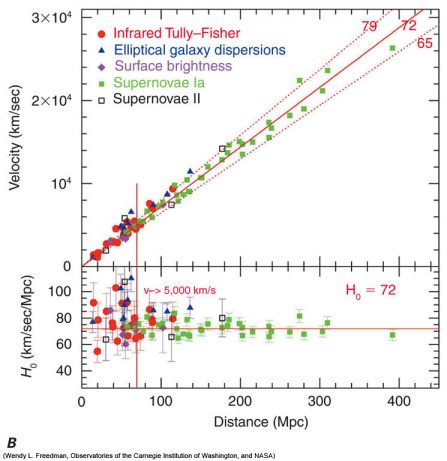|
|
 A plot of velocity against distance made by the HST Key
Project on the Hubble constant, led by Wendy Freedman. The different colours represent different ways of measuring distance – see PHY216 next year for details. The gradient of this line is the Hubble constant – 72 km s-1 Mpc-1 for these data, as shown by the solid red line. The bottom plot shows the differences between the points and the solid line (the residuals). One megaparsec (Mpc) is about 3.3 million light-years.
A plot of velocity against distance made by the HST Key
Project on the Hubble constant, led by Wendy Freedman. The different colours represent different ways of measuring distance – see PHY216 next year for details. The gradient of this line is the Hubble constant – 72 km s-1 Mpc-1 for these data, as shown by the solid red line. The bottom plot shows the differences between the points and the solid line (the residuals). One megaparsec (Mpc) is about 3.3 million light-years.
|
Summary of Lecture 10 – Why is the Night Sky Dark?
- Are we in a special place?
- Early cosmological theories assumed either the Earth or the sun was the
centre of the Universe. This would make our location special.
- Modern theories (backed up by observation) assume we are not in a
special place – and there is no special place in the universe at
all. This view is known as the Cosmological
Principle – which asserts that the Universe looks the same
in all directions and from all locations.
- Why is the night sky dark?
- The darkness of the night sky is unexpected in pre-20th-century
cosmological theories:
- if the Universe is infinitely large,
infinitely old, and static,
then all lines of sight eventually hit a star, and the
night sky has a temperature of at least 3000 K (Olbers'
paradox);
- this is clearly not true, therefore at least one of the
assumptions is false
- despite this, the idea of a static universe still dominated
19th-century thinking:
- Einstein believed this even though his theory of general
relativity naturally predicts an
expanding (or contracting) universe;
- to make a static universe possible, Einstein introduced
another term, the cosmological constant, which
can balance gravity to produce a static model
- (this is a bit like the balance of pressure and gravity in
stars, but unlike stars a universe balanced like this is
not stable)
- Hubble established around 1930 that the redshifts of other galaxies
are proportional to their distance (the constant of proportionality
is now called the Hubble constant):
- this shows that the Universe is expanding;
- it does not mean we are at the centre: any observer
would see the same behaviour;
- running the expansion backwards, assuming speeds do not
change, brings all the galaxies to one point at a certain time
(the Hubble time) in the past;
- (note that Hubble's original value of the constant was
much too big, which made the Hubble time much too small)
- after this discovery Einstein called the introduction of the
cosmological constant "my greatest blunder" (but see later!).
- The expansion of the universe is not like an explosion:
- it is expansion of space and not within space;
- (this is not easy to visualise: helpful models include the
expanding balloon analogy and raisins in a loaf of expanding
bread)
- the expansion of space and the evolution of space-time are
predicted and described by Einstein's General Theory of Relativity
(1915) as solved by Alexander Friedman and Georges Lemaitre in
the 1920s.
- The Hubble law and general relativity led to two main cosmological models,
the Big Bang and the Steady State:
- In the Big Bang theory, the universe has finite age:
- it originated at the Big Bang itself, about 14 billion years
ago;
- Olbers' Paradox is resolved: the universe is not infinitely old,
and therefore the light from many stars has not yet had time
to reach us;
- as the universe expands, it gets steadily cooler (because of
the 'stretching' of light to longer wavelengths) and less
dense, so in the past it was denser and hotter;
- this provides a second possible resolution of Olbers'
Paradox: light from very distant objects would have been
stretched, so that its apparent temperature would be much
less than 3000 K
- (not actually important for starlight in this model,
but see later);
- General Relativity predicts that space-time is
curved:
- the curvature depends on density – and so does the
fate of the universe:
- in simple models, if the density is lower
than a certain critical value the universe will
expand forever;
- if the density is equal to the critical value the universe will still expand
forever, but at an ever-decreasing
rate (it never quite stops: v → 0 as time → ∞)
- if the density is higher, the expansion
will stop and reverse – and the
universe will end in a Big Crunch
- In the Steady State theory, the universe is infinitely
old and looks the same (on average) at any time:
- it has been expanding forever and will continue to expand forever;
- as it expands, new matter is created,
maintaining the average density at a constant value;
- Olbers' Paradox is resolved: the light from distant objects
is highly redshifted, and therefore appears much cooler
than 3000 K, so the night sky is still dark;
- looking at distant objects, i.e. back into the past, should
make no difference: the universe 'then' is the same
(on average) as the universe 'now'.
- The Big Bang and Steady State theories make distinctly
different predictions, which
we can test by observations.
Web links
Go back to main page
Go on to Summary for Lecture 11
|
Hicks Building, Hounsfield Road, Sheffield S3 7RH, UK
|